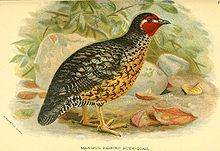- Manipur Bush Quail
-
Manipur Bush Quail 
Conservation status Scientific classification Kingdom: Animalia Phylum: Chordata Class: Aves Order: Galliformes Family: Phasianidae Subfamily: Perdicinae Genus: Perdicula Species: P. manipurensis Binomial name Perdicula manipurensis
(Hume, 1880)The Manipur Bush Quail (Perdicula manipurensis) is a species of quail found in India, inhabiting damp grassland, particularly stands of tall grass, in West Bengal, Assam, Nagaland, Manipur, and Meghalaya.[1]
It was collected and described by Allan Octavian Hume on an ornithological expedition to Manipur in 1881.
P. manipurensis is listed as Vulnerable in IUCN's Red List, as its habitat is small, fragmented, and rapidly shrinking.[2] There was no confirmed sighting of the bird from 1932 until June 2006, when Anwaruddin Choudhury reported spotting the quail in Assam.[3] [4] BBC News quoted the conservation director of the Wildlife Trust of India, Rahul Kaul, as saying, "This creature has almost literally returned from the dead."[3]
History
The following description of the species by Frank Finn (1911) suggests that the species was common in the past.[5]
Native name: Lanx-Soibol, Manipuri.
One of Mr. Hume's most striking discoveries in Manipur, this pretty quail is very distinct in appearance from all our species. Its plumage is slate-colour, mottled with black above, and buff below the breast, this colour broken up into large spots by black markings which form a cross on every feather. The cock has a dark bay face, which at once distinguishes him from the hen. The bill is dark horny, and the legs orange.
In length this species is about seven inches, with a wing a little over three, and a tail of two inches.
Mr. Hume discovered this species himself when in Manipur, and obtained nine specimens (all he saw except two which were lost) after immense labour and two days' beating in an expanse of elephant grass covering broken ground about two miles square. The birds were in two coveys, and those shot were found to have fed upon both seeds and insects A single bird was shot ten days later in the same district, and there is a specimen in the British Museum said to be from Sikkim. But except for these few specimens, nothing more was known of the Manipur bush-quail till 1899, nearly twenty years after Mr. Hume's discovery of the bird, when Captain H. S. Wood, of the Indian Medical Service, presented one to the Indian museum, and Lieutenant H. H. Turner two others. Captain Wood, who had found the species quite common in Manipur, afterwards wrote an interesting note on it in the Asiatic Society's Journal for 1899. He had shot about eighty of these quail, and did not consider them at all uncommon. The native name means "Trap Quail" as the Nagas snare numbers of them in nooses after jungle fires. The birds breed in Manipur, and the egg is large in proportion to the size of the bird, and greenish in colour with black and brown patches; unfortunately Captain Wood's specimens of them got broken in transit. He found the birds hard to see except after the jungle fires from February to April as they kept to dense cover, and even after a fire their dark colour made them hard to see on the burnt grass they were always found close to water. The coveys kept very close when running, and Captain Wood has bagged as many as four at a shot.References
- ^ "Manipur Bush-quail - BirdLife Species Factsheet". http://www.birdlife.org/datazone/species/index.html?action=SpcHTMDetails.asp&sid=207&m=0. Retrieved 2006-06-28.
- ^ "Species Information: Perdicula manipurensis". IUCN Red List of Threatened Species. http://www.iucnredlist.org/search/details.php/16605/summ. Retrieved 2006-06-28.[dead link]
- ^ a b "'Extinct' quail sighted in India". BBC News. 2006-06-28. http://news.bbc.co.uk/2/hi/south_asia/5125244.stm. Retrieved 2006-06-28.
- ^ "Rare quail sighted in Assam after 75 years". Newkerala.com. 2006-06-24. http://www.newkerala.com/news3.php?action=fullnews&id=13306. Retrieved 2006-06-28.
- ^ Finn, Frank (1911), Game birds of India and Asia., Thacker and Spink, Calcutta.
Categories:- IUCN Red List vulnerable species
- Perdicula
- Quails
- Birds of Bangladesh
- Birds of India
Wikimedia Foundation. 2010.

